Energy Production in August 2019
In August, the production of industrial raw coal and crude oil slowed down, while the production of natural gas and electricity increased.
1. Raw coal production slowed down and coal imports accelerated
In August, the output of raw coal was 320 million tons, up by 5.0 percent year-on-year, and the growth rate fell 7.2 percentage points than that of last month; the average daily output was 10.19 million tons, 200 thousand tons less than last month. From January to August, the output of raw coal was 2.41 billion tons, an increase of 4.5 percent over the same period last year.
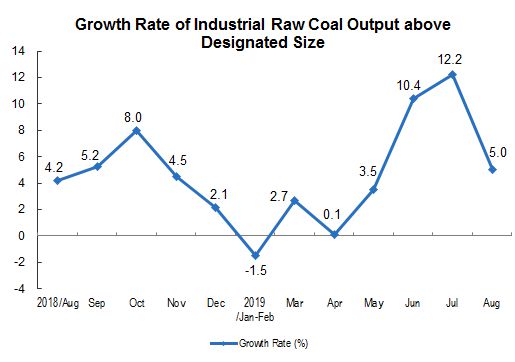
In August, 32.95 million tons of coal were imported, an increase of 14.9 percent year on year, and the growth rate up by 1.5 percentage points than last month. From January to August, 220.28 million tons of coal were imported, an increase of 8.1 percent over the same period of previous year.
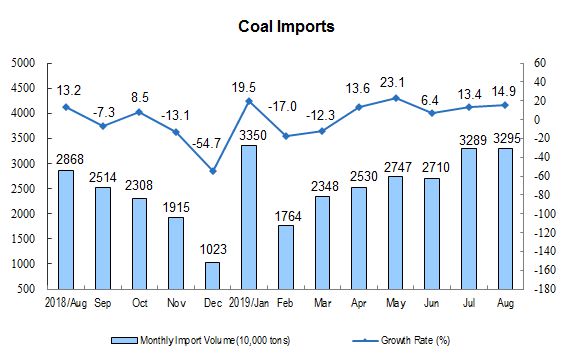
Coal prices were stable. On September 6, the comprehensive trading price of Qinhuangdao 5500 kilocalorie coal was 569 yuan per ton, and 508 yuan per ton for 5000 kilocalories, respectively fell 8 and 3 yuan than that in early August. That of 4500 kilocalories coal was 454 yuan per ton, remained the same level with that in early August.
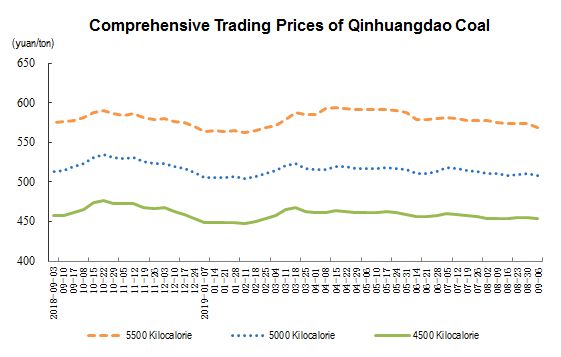
2. Crude oil production slowed down and imports increased
In August, 16.18 million tons of crude oil were produced, an increase of 1.0 percent year on year, and the growth rate fell by 1.5 percentage points compared with last month. The average daily output was 522 thousand tons, 3 thousand tons less than last month. From January to August, 127.49 million tons of crude oil were produced, an increase of 1.0 percent over the same period last year.
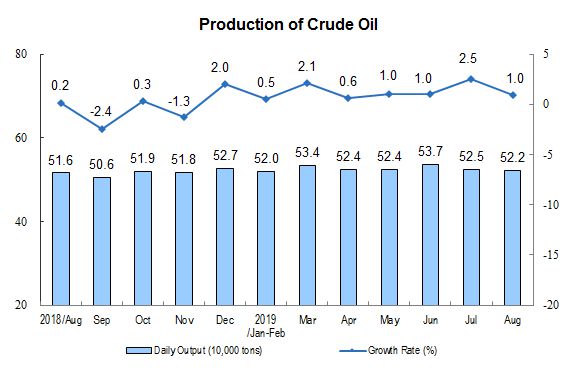
In August, 42.17 million tons of crude oil were imported, up by 9.9 percent year-on-year, and the growth rate declined 4.0 percentage points over the previous month. From January to August, imported crude oil was 327.80 million tons, an increase of 9.6 percent over the same period last year.
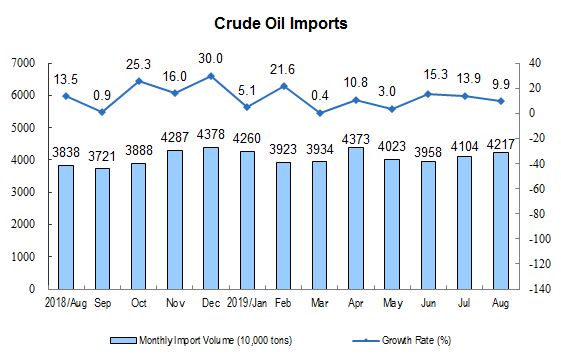
International crude oil prices tumbled in August. The spot FOB price of Brent crude oil on August 30 was 61.0 U.S. dollar per barrel, down 3.1 U.S. dollar from July 31.
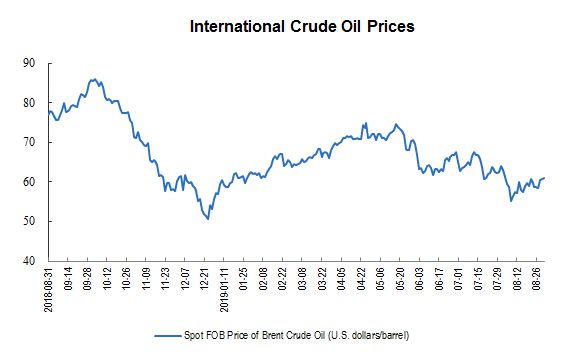
3. The speed of crude oil processing accelerated and the daily average processing volume increased
In August, 54 million tons of crude oil were processed, an increase of 6.9 percent year-on-year, and the growth rate increase of 2.9 percentage points over the previous month. The average daily processing capacity was 1,742 thousand tons, an increase of 45 thousand tons over the previous month. From January to August, 424.16 million tons of crude oil were processed, an increase of 5.9 percent over the same period last year.
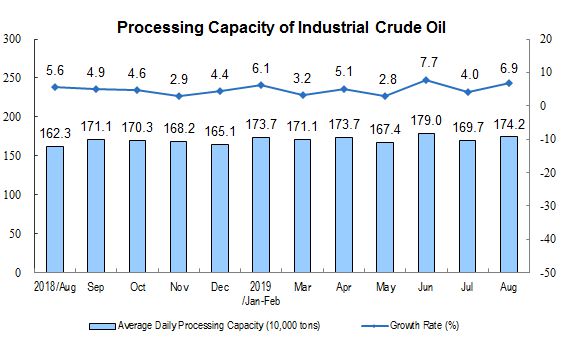
4. Natural gas production was stable and imports kept growing rapidly
In August, the production of natural gas was 13.8 billion cubic meters, up 6.6 percent year-on-year, 0.5 percentage points faster than last month, and the average daily output was 450 million cubic meters, the same as last month. From January to August, 114.1 billion cubic meters of natural gas were produced, an increase of 9.3 percent over the same period last year.
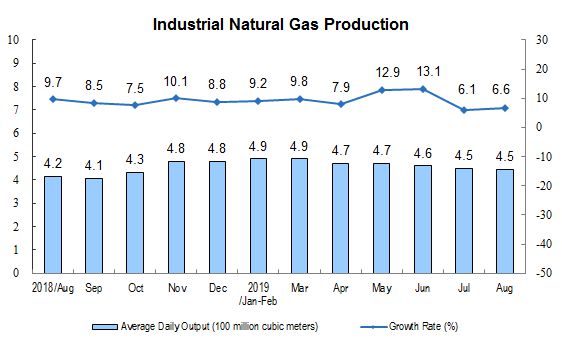
In August, 8.34 million tons of natural gas were imported, an increase of 7.3 percent over the same period last month. From January to August, 63.04 million tons of natural gas were imported, an increase of 10.3 percent over the same period last year.
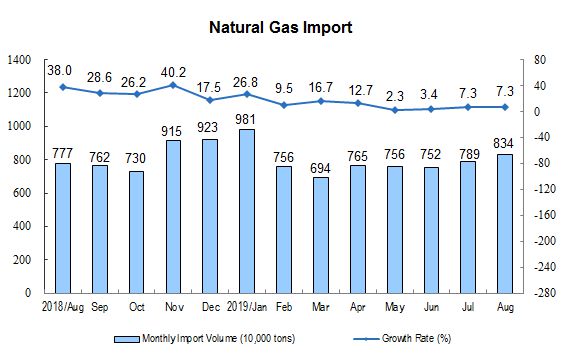
5. Electric power production has accelerated and clean power production has increased rapidly
In August, 668.2 billion kilowatt-hours of power was generated, increased by 1.7 percent year-on-year, 1.1 percentage points faster than last month, and the average daily power generation was 21.56 billion kilowatt-hours, an increase of 360 million kilowatt-hours over last month. From January to August, 4.7 trillion kWh of electricity was generated, an increase of 2.8 percent over the same period last year.

From the perspective of power supply, in August, the decline of thermal power was narrowed, the growth rate of hydropower dropped, wind power turned from negative to positive, and nuclear power and solar power were accelerated. Among them, thermal power decreased by 0.1 percent year on year, the decline narrowed by 1.5 percentage points compared with last month, hydropower increased by 1.6 percent, the growth rate fell by 4.7 percentage points compared with last month; wind power increased by 13.7 percent, the growth rate changed from negative to positive, and fell by 10.8 percent last month; nuclear power and solar power increased by 21.2 and 13.9 percent respectively, and accelerated by 3.0 and 0.7 percentage point.
Annotations:
1. Explanatory Notes
Raw coal: refers to the raw coal produced by a coal mine that has been checked and accepted and meets the quality standards. That is to say, gangue with specified size (including pyrite and other impurities) is selected from coal and the absolute dry ash content of raw coal is less than 40 percent. Although the absolute dry ash content is over 40 percent, the inferior coal which has been mined with the approval of the relevant departments and has consumption demand should also be included in the output of raw coal. Raw coal is divided into anthracite, bituminous coal and lignite. In bituminous coal, it is divided into coking bituminous coal and general bituminous coal. Raw coal does not include stone coal, peat (peat) and gangue mined with the production process of raw coal.
Average daily product output: It is calculated by dividing the total output of Industrial Enterprises above the designated size announced in that month by the calendar days of that month.
2. Statistical Coverage
The statistical caliber of the output data in the report is above the designated size of industry, and the statistical scope is industrial enterprises with annual main business income of more than 20 million yuan.
Because the scope of Industrial Enterprises above the designated size changes every year, in order to ensure that this year's data is comparable with the previous year's, the same period used to calculate the growth rate of various indicators such as product output is consistent with the statistical scope of enterprises in this period, and there is a caliber difference between the data released last year.
3. Survey Methods
Import data comes from the General Administration of Customs, of which August data is express data; coal price data comes from China Coal Market Network; crude oil price data comes from the United States Energy Information Agency (EIA).
4. Conversion relationship of natural gas units: 1 ton is equal to 1380 cubic meters.
